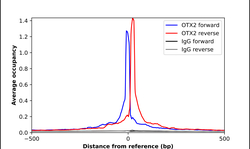Antibody data
- Antibody Data
- Antigen structure
- References [5]
- Comments [0]
- Validations
- Chromatin Immunoprecipitation [1]
Submit
Validation data
Reference
Comment
Report error
- Product number
- HPA000633 - Provider product page

- Provider
- Atlas Antibodies
- Proper citation
- Atlas Antibodies Cat#HPA000633, RRID:AB_1079538
- Product name
- Anti-OTX2
- Antibody type
- Polyclonal
- Description
- Polyclonal Antibody against Human OTX2, Gene description: orthodenticle homeobox 2, Validated applications: IHC, ChIP, Uniprot ID: P32243, Storage: Store at +4°C for short term storage. Long time storage is recommended at -20°C.
- Reactivity
- Human
- Host
- Rabbit
- Conjugate
- Unconjugated
- Isotype
- IgG
- Vial size
- 100 µl
- Concentration
- 0.1 mg/ml
- Storage
- Store at +4°C for short term storage. Long time storage is recommended at -20°C.
- Handling
- The antibody solution should be gently mixed before use.
Submitted references Transplantation of GMP-grade human iPSC-derived retinal pigment epithelial cells in rodent model: the first pre-clinical study for safety and efficacy in China
Single cell transcriptomics reveals lineage trajectory of retinal ganglion cells in wild-type and Atoh7-null retinas
Controlling the Switch from Neurogenesis to Pluripotency during Marmoset Monkey Somatic Cell Reprogramming with Self-Replicating mRNAs and Small Molecules
Stem cells from human exfoliated deciduous tooth exhibit stromal-derived inducing activity and lead to generation of neural crest cells from human embryonic stem cells.
Differential CRX and OTX2 expression in human retina and retinoblastoma
Zhang H, Su B, Jiao L, Xu Z, Zhang C, Nie J, Gao M, Zhang Y, Jin Z
Annals of Translational Medicine 2021;9(3):245-245
Annals of Translational Medicine 2021;9(3):245-245
Single cell transcriptomics reveals lineage trajectory of retinal ganglion cells in wild-type and Atoh7-null retinas
Wu F, Bard J, Kann J, Yergeau D, Sapkota D, Ge Y, Hu Z, Wang J, Liu T, Mu X
Nature Communications 2021;12(1)
Nature Communications 2021;12(1)
Controlling the Switch from Neurogenesis to Pluripotency during Marmoset Monkey Somatic Cell Reprogramming with Self-Replicating mRNAs and Small Molecules
Petkov S, Dressel R, Rodriguez-Polo I, Behr R
Cells 2020;9(11):2422
Cells 2020;9(11):2422
Stem cells from human exfoliated deciduous tooth exhibit stromal-derived inducing activity and lead to generation of neural crest cells from human embryonic stem cells.
Karbalaie K, Tanhaei S, Rabiei F, Kiani-Esfahani A, Masoudi NS, Nasr-Esfahani MH, Baharvand H
Cell journal 2015 Spring;17(1):37-48
Cell journal 2015 Spring;17(1):37-48
Differential CRX and OTX2 expression in human retina and retinoblastoma
Glubrecht D, Kim J, Russell L, Bamforth J, Godbout R
Journal of Neurochemistry 2009;111(1):250-263
Journal of Neurochemistry 2009;111(1):250-263
No comments: Submit comment
Supportive validation
- Submitted by
- Atlas Antibodies (provider)
- Main image

- Experimental details
- ChIP-Exo-Seq composite graph for Anti-OTX2 (HPA000633, Lot B74059) tested in K562 cells. Strand-specific reads (blue: forward, red: reverse) and IgG controls (black: forward, grey: reverse) are plotted against the distance from a composite set of reference binding sites. The antibody exhibits robust target enrichment compared to a non-specific IgG control and precisely reveals its structural organization around the binding site. Data generated by Prof. B. F. Pugh´s Lab at Cornell University.
 Explore
Explore Validate
Validate Learn
Learn Immunohistochemistry
Immunohistochemistry Chromatin Immunoprecipitation
Chromatin Immunoprecipitation